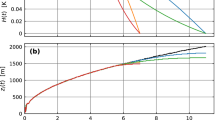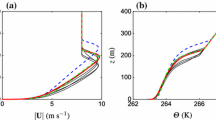Abstract
This study presents the results of large-eddy simulation (LES) of the evening transition in the atmospheric boundary layer in the case of free convection and in the presence of geostrophic wind. The turbulent kinetic energy (TKE) balance and its components are analyzed. It is shown that within the transition, periods of fast and slow decay can be distinguished. The differences in TKE anisotropy between these two periods are demonstrated. During the fast decay period, the majority of the energy within the vertical component is consumed due to inertial movement of the thermals after the cease of convection. This is followed by the TKE redistribution into large-scale horizontal components, which leads to the formation of quasi-horizontal turbulence, where the TKE dissipation is significantly slower in comparison to the isotropic state. It is shown that one-dimensional boundary-layer model, in which turbulent fluxes are parameterized by means of a two-equation closure, is not able to reproduce evening transition dynamics observed in LES. In particular, the use of the gradient approximation in the one-dimensional model leads to the preservation of the convective distribution of the heat flux along the vertical during the transition period and additional TKE generation in the boundary layer due to the action of buoyancy forces. The use of the phenomenological equation for the dissipation rate leads to decreased TKE decay rate during the fast decay period and increased TKE decay rate during the slow decay period. Possible approaches toward modification of the Reynolds-averaged Navier–Stokes (RANS) closures in order to correctly reproduce transition periods of the atmospheric boundary layer are discussed.









Similar content being viewed by others
REFERENCES
R. B. Stull and A. G. M. Driedonks, “Applications of the transilient turbulence parameterization to atmospheric boundary-layer simulations,” Boundary-Layer Meteorol. 40 (3), 209–239 (1987).
A. Debolskiy, E. Mortikov, A. Glazunov, and C. Lüpkes, “Evaluation of surface layer stability functions and their extension to first order turbulent closures for weakly and strongly stratified stable boundary layer,” submitted to Boundary-Layer Meteorol.
E. V. Mortikov, A. V. Glazunov, A. V. Debolskiy, V. N. Lykosov, and S. S. Zilitinkevich, “Modeling of the dissipation rate of turbulent kinetic energy,” Dokl. Earth Sci. 489 (4), 1440–1443 (2019).
G. Svensson, A. A. M. Holtslag, V. Kumar, T. Mauritsen, G. J. Steeneveld, W. M. Angevine, E. Bazile, A. Beljaars, E. I. F. de Bruijn, A. Cheng, L. Conangla, J. Cuxart, M. Ek, M. J. Falk, F. Freedman, et al., “Evaluation of the diurnal cycle in the atmospheric boundary layer over land as represented by a variety of single-column models: The second GABLS experiment,” Boundary-Layer Meteorol. 140, 177–206 (2011).
A. A. M. Holtslag, G. Svensson, P. Baas, S. Basu, B. Beare, A. C. M. Beljaars, F. C. Bosveld, J. Cuxart, J. Lindvall, G. J. Steeneveld, M. Tjernström, and B. J. H. Van De Wiel, “Stable atmospheric boundary layers and diurnal cycles: Challenges for weather and climate models,” Bull. Am. Meteorol. Soc. 94 (11), 1691–1706 (2013).
W. M. Angevine, J. M. Edwards, M. Lothon, M. A. LeMone, and S. R. Osborne, “Transition periods in the diurnally-varying atmospheric boundary layer over land,” Boundary-Layer Meteorol. 177, 205–223 (2020).
A. C. Taylor, R. J. Beare, and D. J. Thomson, “Simulating dispersion in the evening-transition boundary layer,” Boundary-Layer Meteorol. 153, 389–407 (2014).
C. G. Copstein, “Simulating the evening transition in the PBL and evaluating its contribution to the next day prediction ozone peak concentration,” Ph.D. Thesis (University of Houston, 2015).
G. L. Mellor and T. Yamada, “Development of a turbulence closure model for geophysical fluid problems,” Rev. Geophys. 20 (4), 851–875 (1982).
S. S. Zilitinkevich, T. Elperin, N. Kleeorin, I. Rogachevskii, and I. Esau, “A hierarchy of energy- and flux-budget (EFB) turbulence closure models for stably-stratified geophysical flows,” Boundary-Layer Meteorol. 146, 341–373 (2013).
H. Burchard, Applied Turbulence Modelling in Marine Waters (Springer, Berlin, 2002).
H. W. Detering and D. Etling, “Application of the E–ε turbulence model to the atmospheric boundary-layer,” Boundary-Layer Meteorol. 33, 113–133 (1985).
A. Sogachev, M. Kelly, and M. Y. Leclerc, “Consistent two-equation closure modelling for atmospheric research: Buoyancy and vegetation implementations,” Boundary-Layer Meteorol. 145, 307–327 (2012).
C. Zhang, Y. Wang, and M. Xue, “Evaluation of an E–ε and three other boundary layer parameterization schemes in the WRF model over the Southeast Pacific and the Southern Great Plains,” Mon. Weather. Rev. 148 (3), 1121–1145 (2020).
E. H. Langland and C.-S. Liou, “Implementation of an E–ε parameterization of vertical subgrid-scale mixing in a regional model,” Mon. Weather Rev. 124 (5), 905–918 (1996).
R. Nuterman, A. Mahura, A. Baklanov, B. Amstrup, and A. Zakey, “Downscaling system for modelling of atmospheric composition on regional, urban and street scales,” Atmos. Chem. Phys. 21 (14), 11099–11112 (2021).
T. C. Vu, T. Asaeda, and Y. Ashie, “Development of a numerical model for the evaluation of the urban thermal environment,” J. Wind Eng. Ind. Aerodyn. 81 (1–3), 181–196 (1999).
M. Nakanishi and H. Niino, “An improved Mellor–Yamada level-3 model with condensation physics: Its design and verification,” Boundary-Layer Meteorol. 112, 1–31 (2004).
O. El Guernaoui, J. Reuder, I. Esau, T. Wolf, and B. Maronga, “Scaling the decay of turbulence kinetic energy in the free-convective boundary layer,” Boundary-Layer Meteorol. 173 (1), 79–97 (2019).
F. T. M. Nieuwstadt and R. A. Brost, “The decay of convective turbulence,” J. Atmos. Sci. 43 (6), 532–546 (1986).
S.-B. Park, J.-J. Baik, and B.-S. Han, “Role of wind shear in the decay of convective boundary layers,” Atmosphere 11 (6), 622 (2020).
D. Pino, H. J. J. Jonker, J. V.-G. de Arellano, and A. Dosio, “Role of shear and the inversion strength during sunset turbulence over land: Characteristic length scales,” Boundary-Layer Meteorol. 121 (3), 537–556 (2006).
Z. Sorbjan, “Decay of convective turbulence revisited,” Boundary-Layer Meteorol. 82 (3), 503–517 (1997).
J. W. Deardorff, “Convective velocity and temperature scales for the unstable planetary boundary layer and for Rayleigh convection,” J. Atmos. Sci. 27 (8), 1211–1213 (1970).
A. N. Kolmogorov, “On the degradation of isotropic turbulence in an incompressible viscous fluid,” Dokl. Akad. Nauk SSSR 31, 538–540 (1941).
P. G. Saffman, “The large-scale structure of homogeneous turbulence,” J. Fluid Mech. 27 (3), 581–593 (1967).
G. Birkoff, “Fourier synthesis of homogeneous turbulence,” Commun. Pure Appl. Math. 7, 19–44 (1954).
V. N. Lykosov, “The problem of closure of turbulent boundary layer models using equations for kinetic turbulent energy and its dissipation rate,” Izv. Ross. Akad. Nauk: Fiz. Atmos. Okeana 28 (7), 696-704 (1992).
E. Tkachenko, A. Debolskiy, and E. Mortikov, “Intercomparison of subgrid scale models in large-eddy simulation of sunset atmospheric boundary layer turbulence: Computational aspects,” Lobachevskii J. Math. 42 (7), 1580–1595 (2021).
U. Rizza, M. M. Miglietta, G. A. Degrazia, O. C. Acevedo, and E. P. Marques Filho, “Sunset decay of the convective turbulence with large-eddy simulation under realistic conditions,” Phys. A (Amsterdam, Neth.) 392, 4481–4490 (2013).
D. F. Nadeau, E. R. Pardyjak, C. W. Higgins, H. J. S. Fernando, and M. B. Parlange, “A simple model for the afternoon and early evening decay of convective turbulence over different land surfaces,” Boundary-Layer Meteorol. 141 (2), 301–324 (2011).
A. Glazunov, Ü. Rannik, V. Stepanenko, V. Lykosov, M. Auvinen, T. Vesala, and I. Mammarella, “Large-eddy simulation and stochastic modeling of Lagrangian particles for footprint determination in the stable boundary layer,” Geosci. Model Dev. 9 (9), 2925–2949 (2016).
M. Germano, U. Piomelli, P. Moin, and W. H. Cabot, “A dynamic subgrid-scale eddy viscosity model,” Phys. Fluids A 3 (7), 1760–1765 (1991).
D. K. Lilly, “A proposed modification of the Germano subgrid-scale closure method,” Phys. Fluids A 4 (3), 633–635 (1992).
E. Bou-Zeid, C. Meneveau, and M. Parlange, “A scale-dependent Lagrangian dynamic model for large eddy simulation of complex turbulent flows,” Phys. Fluids 17 (2), 025105-1–025105-18 (2005).
C. Meneveau, T. S. Lund, and W. H. Cabot, “A Lagrangian dynamic subgrid-scale model of turbulence,” J. Fluid Mech. 319, 353–385 (1996).
D. S. Gladskikh, V. M. Stepanenko, and E. V. Mortikov, “The effect of the horizontal dimensions of inland water bodies on the thickness of the upper mixed layer,” Water Resour. 48 (2), 226–234 (2021).
E. Kadantsev, E. Mortikov, and S. Zilitinkevich, “The resistance law for stably stratified atmospheric planetary boundary layers,” Q. J. R. Meteorol. Soc. 147 (737), 2233–2243 (2021).
E. V. Mortikov, “Numerical simulation of the motion of an ice keel in a stratified flow,” Izv., Atmos. Ocean. Phys. 52 (1), 108–115 (2016).
E. V. Mortikov, A. V. Glazunov, and V. N. Lykosov, “Numerical study of plane Couette flow: Turbulence statistics and the structure of pressure-strain correlations,” Russ. J. Num. Anal. Math. Model. 34 (2), 119–132 (2019).
Y. Morinishi, T. S. Lund, O. V. Vasilyev, and P. Moin, “Fully conservative higher order finite difference schemes for incompressible flows,” J. Comput. Phys. 143, 90–124 (1998).
D. L. Brown, R. Cortez, and M. L. Minion, “Accurate projection methods for the incompressible Navier–Stokes equations,” J. Comput. Phys. 168, 464–499 (2001).
Y. Zang, R. L. Street, and J. Koseff, “A dynamic mixed subgrid-scale model and its application to turbulent recirculating flows,” Phys. Fluids A 5 (12), 3186–3196 (1993).
T. S. Lund, “On the use of discrete filters for large eddy simulation,” in Annual Research Briefs (Stanford University, Center for Turbulence Research, 1997), pp. 83–95.
A. V. Debolskiy, V. M. Stepanenko, A. V. Glazunov, and S. S. Zilitinkevich, “Bulk models of sheared boundary layer convection,” Izv., Atmos. Ocean. Phys. 55 (2), 139–151 (2019).
V. Wong and D. K. Lilly, “A comparison of two subgrid closure methods for turbulent thermal convection,” Phys. Fluids 6 (2), 1017–1023 (1994).
E. V. Tkachenko, A. V. Debolskiy, and E. V. Mortikov, “Analysis of turbulent kinetic energy decay power law in atmospheric boundary layer models,” IOP Conf. Ser.: Earth Environ. Sci. 611 (1), 012–014 (2020).
E. Tkachenko, A. Debolskiy, E. Mortikov, and A. Glazunov, Large-eddy simulation and parameterization of decaying turbulence in the evening transition of atmospheric boundary layer, Supplementary dataset (2021). https://doi.org/10.23728/b2share.cb7f24996d234148a56b4444875226d0
ACKNOWLEDGMENTS
The study was conducted using the equipment of the Center for Collective Use of Ultra-High-Performance Computing Resources of Moscow State University. The data of the numerical experiments are available at the website of the EUDAT Collaborative Data Infrastructure (EUDAT CDI) [48].
Funding
This study was conducted with the support of the Russian Foundation for Basic Research (grant no. 20-05-00776) and President of the Russian Federation grant to young scientists no. MK-1867.2020.5, as well as with the partial support of the Brain, Cognitive Systems, Artificial Intelligence scientific and educational interdisciplinary school of Moscow University.
Author information
Authors and Affiliations
Corresponding author
Ethics declarations
The authors declare that they have no conflict of interest.
Additional information
Translated by M. Chubarova
Rights and permissions
About this article
Cite this article
Tkachenko, E.V., Debolskiy, A.V., Mortikov, E.V. et al. Large-Eddy Simulation and Parameterization of Decaying Turbulence in the Evening Transition of the Atmospheric Boundary Layer. Izv. Atmos. Ocean. Phys. 58, 219–236 (2022). https://doi.org/10.1134/S0001433822030112
Received:
Revised:
Accepted:
Published:
Issue Date:
DOI: https://doi.org/10.1134/S0001433822030112




